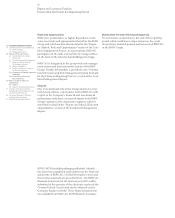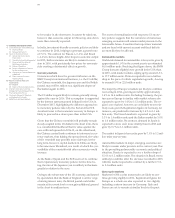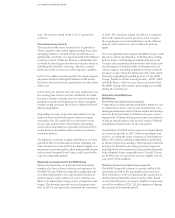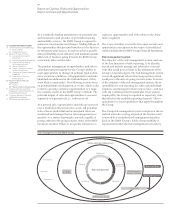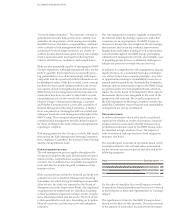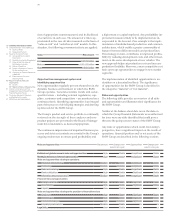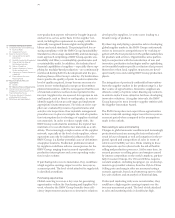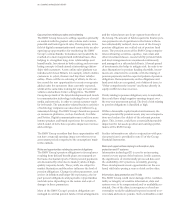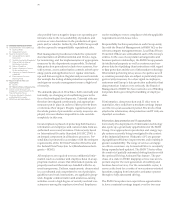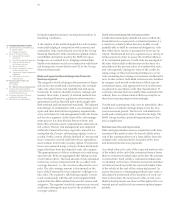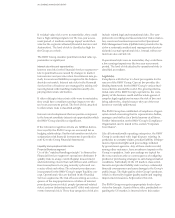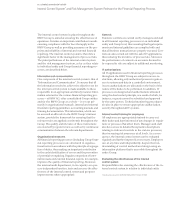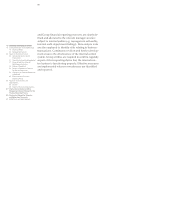BMW 2015 Annual Report Download - page 72
Download and view the complete annual report
Please find page 72 of the 2015 BMW annual report below. You can navigate through the pages in the report by either clicking on the pages listed below, or by using the keyword search tool below to find specific information within the annual report.
72
18 COMBINED MANAGEMENT REPORT
18
General Information on the
BMW
Group
18 Business Model
20 Management System
23 Report on Economic Position
23 General and Sector-specific
Environment
27 Overall Assessment by Management
27
Financial and Non-financial
Performance Indicators
29 Review of Operations
49 Results of Operations, Financial
Position and Net Assets
59 Comments on Financial Statements
of BMW AG
62 Events after the End of the
Reporting Period
63 Report on Outlook, Risks and
Opportunities
63 Outlook
68 Report on Risks and Opportunities
81 Internal Control System and Risk
Management System Relevant for
the
Financial Reporting Process
83 Disclosures Relevant for Takeovers
and Explanatory Comments
87
BMW Stock and Capital Markets
Risks arising from the tightening of laws and regulations
One of the greatest risks for the automobile industry is
the possible threat of short-term tightening of laws
and
regulations, as they could give rise to significantly
higher levels of investment and ongoing expenses, and
perhaps more importantly, result in changes in cus-
tomer
behaviour. The potential tightening of consumer
protection laws could also result in a greater number of
recalls. In some cases, changes in customer behaviour
are not only brought on by new regulations, but also
through changes in public opinion, values, environmen-
tal issues and fuel / energy prices. There is a clear move
towards increasingly stringent vehicle emissions regu-
lations,
particularly for conventional drive systems, not
only in the developed markets of Europe and North
America, but also in emerging markets such as China.
The BMW Group counters this risk with its Efficient
Dynamics technology and continues to play a pioneering
role in the premium segment by continually reducing
both fuel consumption and emissions. Since 2013, elec-
tric drive systems built into BMW i vehicles have in-
creasingly broadened the mix on offer, thus bolstering
the BMW Group’s efforts to comply with statutory car-
bon emissions regulations and requirements. The BMW
Group is investing in the development of sustainable
drive technologies and materials, with the aim of
pro-
viding highly efficient vehicles for individual mobility in
the premium segment, both now and in the future.
Further significant risks could be triggered by the
tight
ening of existing import and export regulations,
re-
sulting primarily in additional expenses, but also in re-
strictions in the import and export of vehicles and / or
parts. Changes in the legal business environment are
monitored and assessed regularly by the relevant central-
ised
departments, thus ensuring that the BMW Group
always complies with statutory requirements. The impact
of legislation that has either been enacted or is likely to
be enacted is taken into account in the outlook.
Employees make a vital contribution to sustainable
growth and improved profitability through their innova-
tive skills. One prerequisite in this regard is a consistent
strategic approach to the management of human
re-
sources, even in the event of changes in the legal frame-
work. The BMW Group has put appropriate measures in
place for such eventualities. Risk amounts and earnings
impact in this category are measured on the basis of ex-
tensive scenario analyses.
If strategic and sector category risks were to materialise,
they could have a high earnings impact over the two-
year assessment period. The amounts of risk attached to
strategic and sector-specific risks are classified as high.
Strategic and sector opportunities
Additions to the product and mobility portfolio and
ex-
pansion in growth regions are seen as the most im-
portant
opportunities for growth in the medium to long
term.
Remaining on growth course depends above all on the
ability to develop innovative products and bring them
to market. The introduction of the BMW i brand opens
up new customer target groups for the Group and con-
solidates the position of BMW as a sustainable, forward-
looking brand. BMW i products can be seen as “empower-
ment projects” for new technologies and processes, which
may also benefit other vehicle concepts. The existing
product portfolio has been expanded to include mobility
services such as DriveNow, ChargeNow and ParkNow.
In 2015, the BMW Group entered new segments with
the BMW 2 Series Active Tourer and the 2 Series Gran
Tourer. The market acceptance and sales volumes of
product innovations that are either planned for the future
or have recently been launched could turn out to be
greater than predicted in the outlook. In the short term,
however, any potentially positive impact is classified as
insignificant
.
The long-term trend towards greater sustainability pro-
vides opportunities to boost sales of sustainable products
and, under the right circumstances, achieve better sell-
ing prices. Innovations such as the BMW i 3 and i8 in the
field of electric mobility or Efficient Dynamics across the
entire product portfolio provide excellent platforms for
future growth. Potential also exists in engaging in new
product and market categories and developing new cus-
tomer target groups. New business models and coopera-
tion
arrangements with the BMW Group’s growing
network of business partners often provide the best
means to exploit these opportunities. Good examples
are the implementation of the 360° ELECTRIC portfolio
in the field of electric mobility, the partnership with
Sixt in the field of mobility services, and collaboration
with Toyota on developing a hydrogen fuel cell system.
The BMW Group is constantly refining the tools it uses
to recruit staff, encourage career development and re-
tain employees within the Group. This environment of-
fers people the ideal situation in which to develop their
skills. If these measures generate greater benefits than
currently expected, the BMW Group’s revenues, results
of operations and cash flows can be positively impacted


